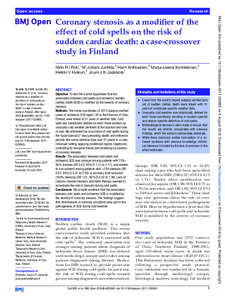Coronary stenosis as a modifier of the effect of cold spells on the risk of sudden cardiac death : a case-crossover study in Finland
Ryti, Niilo R I; Junttila, M Juhani; Antikainen, Harri; Kortelainen, Marja-Leena; Huikuri, Heikki V; Jaakkola, Jouni J K (2018-08-05)
Ryti NRI, Junttila MJ, Antikainen H, et al. Coronary stenosis as a modifier of the effect of cold spells on the risk of sudden cardiac death: a case-crossover study in Finland. BMJ Open 2018;8:e020865. doi: 10.1136/bmjopen-2017-020865
© Author(s) (or their employer(s)) 2018. Re-use permitted under CC BY-NC. No commercial re-use. See rights and permissions. Published by BMJ. This is an open access article distributed in accordance with the Creative Commons Attribution Non Commercial (CC BY-NC 4.0) license, which permits others to distribute, remix, adapt, build upon this work non-commercially, and license their derivative works on different terms, provided the original work is properly cited, appropriate credit is given, any changes made indicated, and the use is non-commercial. See: http://creativecommons.org/licenses/by-nc/4.0/.
https://creativecommons.org/licenses/by-nc/4.0/
https://urn.fi/URN:NBN:fi-fe2018110947757
Tiivistelmä
Abstract
Objective: To test the a priori hypothesis that the association between cold spells and ischaemic sudden cardiac death (SCD) is modified by the severity of coronary stenosis.
Methods: The home coordinates of 2572 autopsy-verified cases of ischaemic SCD aged ≥35 in the Province of Oulu, Finland, were linked to 51 years of weather data. Cold spell was statistically defined for each home address as unusually cold weather pertinent to the location and time of year. We estimated the occurrence of cold spells during the hazard period (7 days preceding death) and reference periods (the same calendar days over 51 years) in a case-crossover setting applying conditional logistic regression, controlling for temporal trends and stratifying by severity of coronary stenosis.
Results: The association between cold spells and ischaemic SCD was stronger among patients with 75%–95% stenosis (OR 2.03; 95% CI 1.31 to 3.17), and weaker to non-existent among patients with <75% stenosis (OR 0.97; 95% CI 0.37 to 2.55) or coronary total occlusion (100% stenosis) (OR 1.01; 95% CI 0.52 to 1.96). Lack of calcium-channel blockers and statin therapy seemed to accentuate the role of stenosis during cold spells.
Conclusions: We provide evidence that the association between cold spells and ischaemic SCD is modified by the severity of coronary stenosis. The findings suggest that disturbances in coronary circulation play part in the pathogenesis of SCD during cold weather.
Kokoelmat
- Avoin saatavuus [32150]

